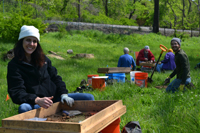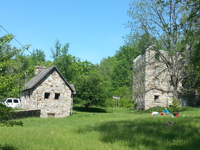 |
| WSSI archeologists Susan Grealy and Daniel Osborne assisting volunteers with excavations. |
Throughout the month of May, archeologists with Wetland Studies and Solutions, Inc. (WSSI) volunteered alongside avocational archeologists working under the supervision of Dr. Kay McCarron and Becky Garber on behalf of the Turn the Mill Around Campaign. The Campaign is a 501(c) (3) non-profit organization dedicated to the restoration and preservation of Chapman's Mill (also known as Beverly's Mill), a gristmill located on Broad Run, along the boundary of Fauquier and Prince William Counties, which can easily be seen from Interstate 66 along Thoroughfare Gap. Ongoing archeological investigations include exploratory excavations intended to develop a more complete understanding of the evolution of the industrial complex from the 1740s through the 1950s and the role of the mill in the colonial economy of the region. The archeological survey is being conducted in advance of efforts to transform the historic industrial complex into a historical public park.
Drawing on their familiarity with soil stratigraphy from work on multiple sites in the region, WSSI archeologists assisted the site supervisor in creating preliminary interpretations of the soil layers encountered during the excavations. These interpretations will be revisited and refined once the analysis of the artifacts from this season's excavations is complete.
On the final day of our assistance to the Campaign, WSSI provided land surveying equipment and trained staff to generate a highly accurate map of the excavations completed at the site over the last two years. This step is crucial to the next phase of the archeological investigations, which will further explore the portions of the site with the greatest potential for yielding new information about the history of the mill and surrounding structures, as well as the Native American prehistory of the site.
About Chapman's Mill
 |
| Chapman's/Beverly mill and mill store as they appear today. Click for larger image. |
Chapman's Mill was constructed in 1742 by Jonathan and Nathaniel Chapman. The mill's location was strategic as grains from local farms and farms in the Shenandoah Valley could be easily transported to the mill; flour produced at the mill was delivered to Alexandria's seaport for shipment to markets elsewhere in the British American colonies, Europe and South America. The mill was improved in 1758 and soon became a prosperous enterprise that processed much of the wheat and corn grown in the region for export. By 1858, the mill was expanded to seven stories and served as a model for cutting edge mill technology. Completion of the Manassas Gap Railroad between northern Virginia and the Shenandoah Valley in 1859 provided a rail link between the mill, regional farms and urban distribution centers.
During the Civil War, the Battle of Thoroughfare Gap, also known as the Battle of Chapman's Mill, occurred at the site on August 28, 1862. In financial ruin, the Chapman family sold the mill to Robert and William Beverly in 1871. Beverly's Mill was operated by several millers in the late 19th and early 20th century until it was finally closed in 1951 (Jones 1981).
Although it stood abandoned throughout the second half of the 20th century, the mill structure remained relatively well preserved with most of the milling equipment intact. However, a disastrous fire in 1998 gutted the structure, leaving only the exterior stone walls standing. The remains of the mill were stabilized by the Turn the Mill Around Campaign in 2004 and ongoing archeological excavations seek to provide information about the history of the property that have been otherwise lost to history.
Throughout the 270+ year history of the mill numerous buildings were constructed, remodeled, and demolished on the property; the remnants of these remain buried across the site. To date, the archeological excavations have revealed the presence of at least three buildings, in addition to the mill and a mill store that was constructed in the early 20th century. Additionally, the recovery of prehistoric stone tools at the site, suggest the mountain pass was also utilized by Native Americans travelling between the Coastal Plain and Piedmont regions of Virginia.
For more information on Chapman's Mill or the Turn the Mill Around Campaign, visit: http://www.chapmansmill.org.
To learn more about how WSSI archeology services can assist with the permitting process for your upcoming development projects, please contact Boyd Sipe or Craig Rose.
Jones, Frances L.
1981 Beverley (Chapman's) Mill, Thoroughfare Gap, Virginia: A History and Preservation Plan. A Thesis Submitted to the Faculty of the Graduate School of Arts and Sciences of The George Washington University.
Mullen, John and Jeremy Smith
2013 Public History for the Villages of Piedmont II. Thunderbird Archeology, a division of Wetland Studies and Solutions. Gainesville, Virginia.
|